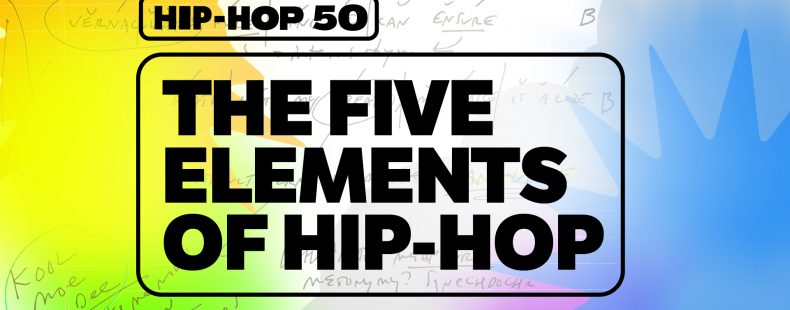On August 11, 1973, DJ Kool Herc hosted a back-to-school party in the Bronx. At that time, different like-minded communities came together to party, and in doing so, they created a new cultural movement that would dramatically shape popular culture forever. That movement would be called hip-hop.
The name hip-hop wasn’t used yet in 1973, and no one at the time interpreted the gathering, or those that followed throughout New York, as a meeting of “elements” that coalesced into a cultural movement. Today, though, it is often said that different elements combined on that day in 1973 to create what we call hip-hop.
Sources disagree on exactly how many hip-hop elements there are, but these five in particular are mentioned most often:
- MCing
- DJing
- Breakdancing
- Graffiti
- Knowledge
While we will look more closely at these five, we acknowledge that there are other potential elements as well. Some other examples of cited elements include fashion, beatboxing, and theater.
MCing (Oral)
The oral element of hip-hop is referred to as MCing or rapping. MC is short for master of ceremonies and is often written as emcee. In hip-hop, MCing is the act of singing or rhythmically rhyming while a DJ plays beats. MCing is said to have emerged during the 1970s, but it traces its origins back through African culture and oral traditions and may have been influenced by other sources such as the Jamaican practice of toasting (giving shout-outs and talking over the music).
DJing (Aural)
DJ is short for disc jockey, a term that dates back to the 1940s. In hip-hop, a DJ is an artist that uses turntables and mixing techniques to create music and beats. An MC/rapper (which could be the DJ themselves) accompanies this music with rhymes and vocals.
DJ Kool Herc, often referred to as “the Father of Hip-Hop,” is credited as the inventor of hip-hop music. He was the DJ at the 1973 party that birthed hip-hop, and he used turntables and mixers to make breakbeats of funk and soul music. According to Herc, to DJ is “to have the insight to motivate the crowd. To have the crowd at your fingertips.”
Breakdancing (Physical)
The art of breakdancing, also known as breaking or b-boying/b-girling, is said to have originated in New York City during the late 1960s and early 1970s. The break in breakdancing refers to the breaks and breakbeats in music made by early hip-hop DJs like DJ Kool Herc. Breakdancing is an especially energetic and acrobatic form of dance that often uses elaborate choreography, footwork, and movements. Today, breakdancing has reached mainstream acceptance to the point of being a 2024 Olympic event.
Graffiti (Visual)
Graffiti, as you likely know, is the act of writing or painting symbols, markings, writing, or other things on walls or buildings. As an act of vandalism, graffiti dates back to ancient times. Modern artistic graffiti, also known as tagging or writing, is said to date back to the ’60s in the city of Philadelphia. Darryl “Cornbread” McCray wrote his nickname on walls and buildings across Philadelphia, which inspired other artists to do the same and eventually created what McCray describes as a “social uprising.”
Over time, this artistic movement managed to spread to neighborhoods in New York City, where it combined with the other elements of hip-hop that likewise encouraged expressing oneself through art. McCray still emphasizes the importance of graffiti when it comes to hip-hop culture, claiming that tagging is the oldest, most important element of hip-hop and wouldn’t exist without it: “There is no hip-hop artist before me… New York put a title on it and called it hip-hop, but the foundations were already established.”
Knowledge (Mental)
The previous four elements appear in nearly every discussion of hip-hop. While other potential elements vary by source, the most commonly included “fifth element” of hip-hop is knowledge. The term knowledge in hip-hop refers to the straightforward knowledge of how to rap, DJ, breakdance, or make graffiti, but it also refers to other knowledge a person needs to be a part of the hip-hop community, such as self-knowledge and knowledge of social and political issues.
The idea that knowledge is the fifth element of hip-hop is credited to Afrika Bambaataa, an influential DJ in the early days of hip-hop. He considers knowledge to be the most important element of them all. According to him, a person cannot MC, DJ, breakdance, or make graffiti without having knowledge, the fifth element that “brings it all together.”
Many have since agreed with the importance of knowledge in hip-hop culture. Hip-hop is often used for social change and as a means to give a voice to oppressed peoples. If a person lacks knowledge of the world and their place in it, they won’t be able to express themselves or successfully deliver their message.
@dictionarycom We asked music fans on the street: “how do you define hip-hop?” Listen to their answers, and let us know how you define hip-hop in the comments below! #hiphop50 #hiphopanniversary #hiphop #music #language #hiphop50th #hiphop50thanniversary #vocabulary














